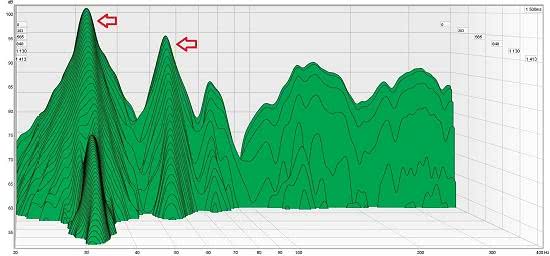
Why should you fix your room acoustics?
There are two main reasons for fixing your room acoustics.
- Nothing affects the sound from your speakers more than the room acoustics. The variation in level between two different bass frequencies can easily exceed ±10 dB in an untreated room. Some bass frequencies – called standing waves – will have a prolonged reverberation time and thus create a bass energy build-up in the room.
Hard reflections off the walls, floor, and ceiling will affect your listening experience more than you think. Your brain will try to separate the hard reflections from the direct sound, but it can’t, because the reflections arrive with a very short time delay. This has a fatiguing effect on your brain, making you less creative and unable to fully enjoy your sound system.
The use of a digital “room correction” system might help iron out the most prominent bass frequencies in the listening position, but unfortunately it can’t do anything about the prolonged reverberation time of the standing waves. How could it? By capturing the sound once it has left the speakers? - As soon as you walk into a room, you are subconsciously affected by its acoustic properties. If the acoustics are too busy – like in a modern café with hard surfaces and no acoustic treatment – you feel uneasy and stressed.
If the acoustics are too damped, with curtains and thick absorbers, you will most likely get the feeling of the walls moving in on you.
Either way, the acoustics will affect your sense of space in a room – for the better or for the worse.
What’s the hardest part of treating the room acoustics?
Getting started …
How do you get started?
Every room is unique and requires a bit of detective work. If you’re uncertain about where to begin, please don’t hesitate to contact one of our product specialists. Their contact information is available at the end of this document.
However, there are some very fundamental ways to get started. Read on!
Hard reflections
Sound waves will bounce off a hard surface is the same way light reflects in a mirror.
The green arrows represent the direct sound from the speakers. The other arrows represent hard reflections bombarding the listener.


How do hard reflections affect the sound?
It takes a sound wave about three milliseconds to travel through one meter of air – which means that the reflections are slightly delayed in time when they reach the listening position. The reflections affect the frequency response, stereo panorama, depth and phantom center – making the overall sound less detailed. It’s also fatiguing listening to music in a room with prominent hard reflections.
Treating hard reflections with absorption
By using a mirror, you can easily identify the hard reflections. Have a friend or spouse sit in the listening position, then put a small mirror flat onto a wall, move the mirror until your friend can see either of the two speakers in the mirror – there’s your hard reflection. Put a small piece of tape to mark the position. Continue the routine until you have found as least one position on each side wall and two on the front wall. The ceiling will also produce hard reflections, and being the room’s largest untreated surface, it’s quite beneficial treating it with absorbers and diffusers. Putting a thick rug on the floor will also help dampen some of the hard reflections.

